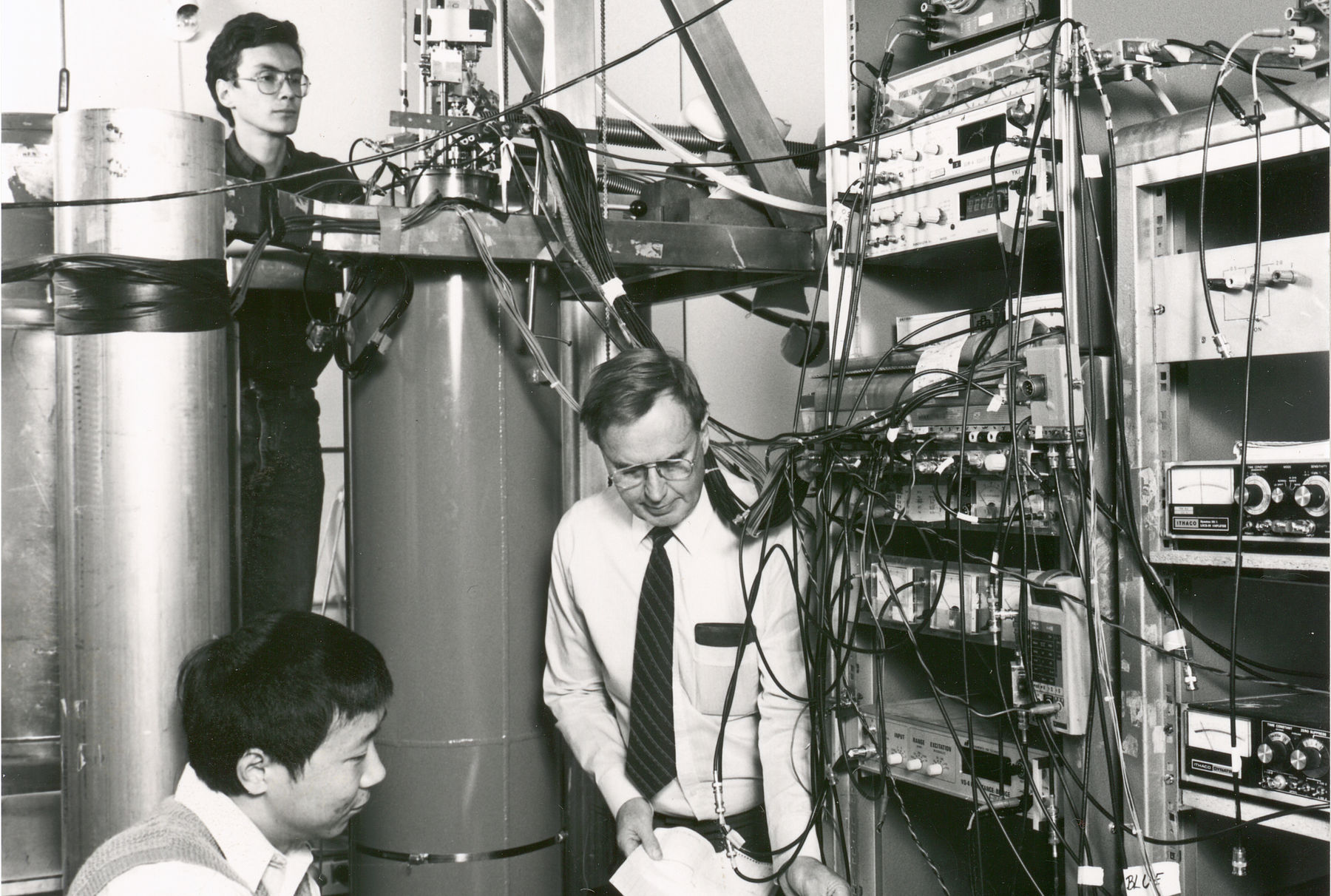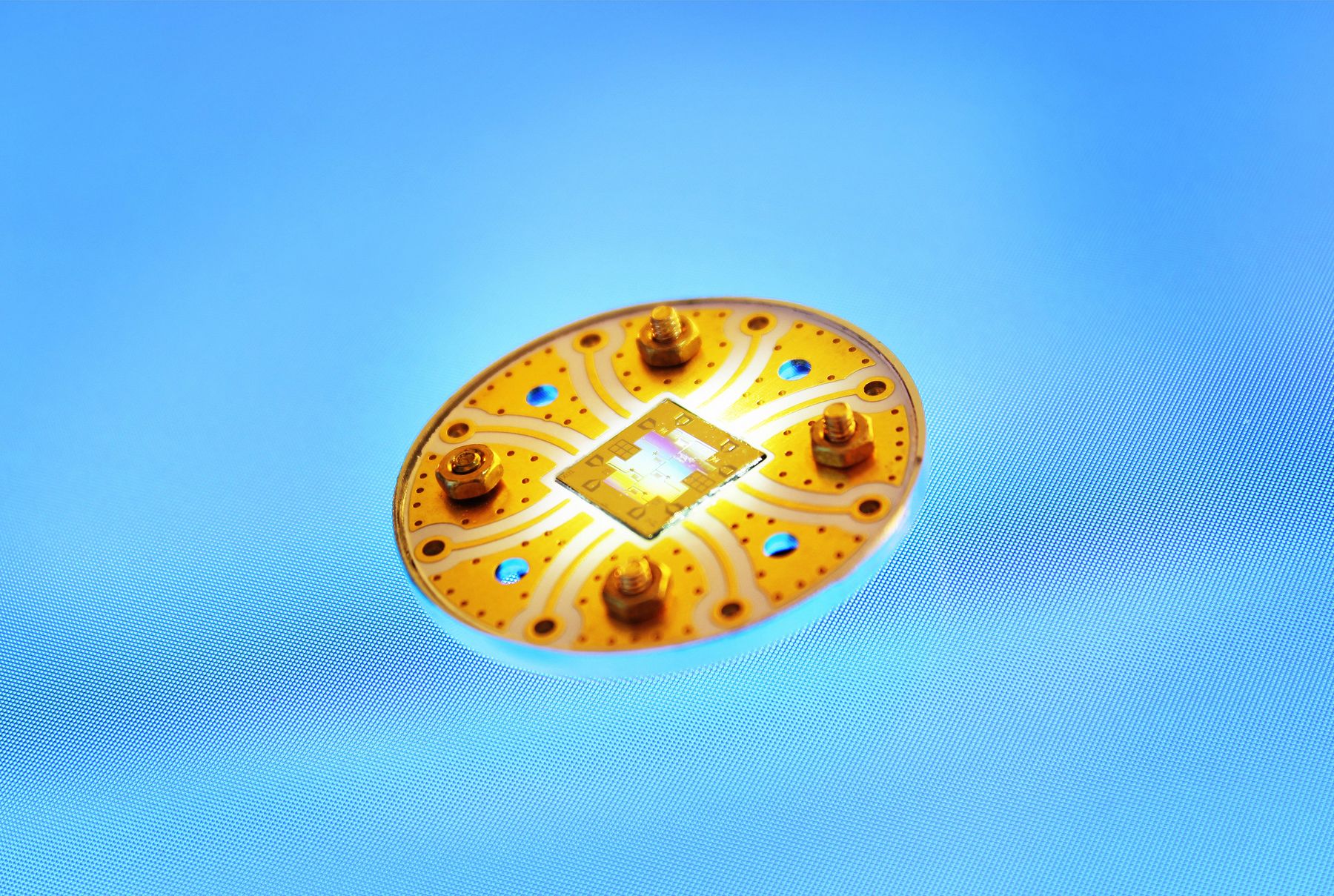HIGH ACHIEVEMENTS IN LOW TEMPERATURES:
OTANIEMI AND QUANTUM TECHNOLOGY

1970: The world's first super-refrigerator is manufactured in Otaniemi
The Low Temperature Laboratory gained recognition for superfluidity research and record low temperatures.
In the spring of 1970, Otaniemi made scientific history: the first cryostat designed for research at ultra-low temperatures was completed at the Helsinki University of Technology’s new Low Temperature Laboratory. The construction of the super-refrigerator, seated on a suspended concrete slab weighing six tons, was led by the founder of the Low Temperature Lab, Professor and Academian Olli Lounasmaa (1930–2002).
The new cryostat was able to refrigerate samples to sub-millikelvin temperatures for the first time in world history. ‘At the time you couldn't get refrigeration units off the shelf, you had to build them yourself. Lounasmaa and his collaborators were very talented at that,’ says Aalto University professor Pertti Hakonen.
Many fascinating physical phenomena don't appear until the temperature approaches absolute zero: 0 Kelvin or –273,15 degrees Celsius.
For example, metals become superconductingat very low temperatures, allowing electric current to flow without loss. The gases helium-3 and helium-4 become superfluid liquids at low temperatures, losing all viscosity or internal friction. Superfluids can remain in constant motion and, for example, escape over the edge of a container.
Superconductivity and superfluidity are important phenomena in fundamental physics. The helium-3 superfluid, for example, can be used to investigate both turbulence and cosmology.
The Low Temperature Laboratory rose to international acclaim by validating the superfluidity of helium-3 in 1973. Its early scientific successes also included observing quantum vortices in rotating helium-3 superfluid in 1981.
‘Finding vortices was no surprise, but the number of different variants was,’ says Hakonen, who participated in measurements for the study.
The Low Temperature Laboratory became world famous when it achieved record low temperatures as a side product of its research. The world's coldest temperature in solid matter (0.1 nanokelvin) was also achieved in Otaniemi in 1999.
High-quality research and apprenticeship-like training
In addition to efficient refrigeration units, research at the Low Temperature Lab has produced other technologies, such as the SQUID sensors designed for measuring weak magnetic fields. These are used, for example, in magnetoencephalography (MEG) measuring the magnetic fields produced by neuronal currents and as the basis for qubits in a quantum computer.
The Low Temperature Laboratory is also the birthplace of the Helsinki-based company Bluefors, which manufactures tailor-made refrigerator units for research purposes and quantum computers used around the world.
Nowadays, the Low Temperature Laboratory is a globally recognized research unit for superconducting quantum technology and nanoelectronics. Hakonen’s research group is currently working to develop a LED light source based on the quantum entanglement of photon pairs. In the future, this research may enable interaction between quantum computers at a distance.
According to Hakonen, the priorities of the Low Temperature Laboratory are the same as they were in the early days. ‘First and foremost, we stand for high-quality research and apprenticeship-like training of graduate students,’ he says.
Text by Panu Räty

Jukka Pekola: Quantum technology requires cutting-edge equipment and persistence in fundamental research
Collaboration with best partners around the world is equally important. The National Centre of Excellence – Quantum Technology Finland (QTF) investigates new phenomena and devices, and provides a seedbed for applications in academia and industry.
Quantum technology promises enormous opportunities in a wide range of applications, including the pharmaceutical industry, material engineering, the energy sector, sensitive measurements, and artificial intelligence. However, developing quantum devices requires broad-based fundamental research.
Professor Jukka Pekola, who heads QTF, says that a significant part of the quantum research carried out at Aalto University is related to superconductivity. For example, development of quantum computers is largely based on qubits made from superconductors.
Another central research area is novel quantum materials. Materials are investigated theoretically as well as through experiments using combinations of layers that are just a single atom thick.
‘The development of quantum devices depends entirely on whether laboratories can produce quantum systems in an orderly manner to use in applications,’ Pekola says. Other important research topics include the basic phenomena of quantum mechanics, quantum communication, and most recently algorithms needed in future quantum computing.
Pekola himself works on quantum thermodynamics, which describes heat transport in superconducting nanostructures. One of the challenges of quantum physics is that the measurement process may alter the object of the measurement. QTF research groups have already developed ultrasensitive quantum detectors that can be used to measure the thermal energy in a quantum system without significantly impacting the quantum states to be measured.
Expert zone
The SQUID sensors at the Low Temperature Laboratory are a prime example of how experiments can produce reliable technology over the long term. The first tests with the SQUID sensors designed for measuring weak magnetic fields were made at the Helsinki University of Technology half a century ago. ‘Now the manufacturing process is routine, and they can be produced for many different applications needing high-sensitivity sensors,’ Pekola says.
The practical cornerstone for quantum research in Finland is the OtaNano national research infrastructure. The platform, operated by Aalto University and VTT, includes the Low Temperature Laboratory, the Nanofab of Micronova, for micro- and nanotechnology, and the Nanomicroscopy Center, which provides high resolution microscopy.
‘Infrastructures are of vital importance to us,’ Pekola says. He is also the acting director of InstituteQ, the Finnish Quantum Institute, which brings together quantum experts from Aalto University, the University of Helsinki, and VTT Technical Research Centre of Finland.
The combination of experimental, theoretical and applied research bears fruit in the birth of new companies. Bluefors, and more recently IQM, which is developing a Finnish quantum computer, and Algorithmiq are examples of “quantum companies” originating from the centres of excellence.
Pekola is proud of the long-term research carried out at the national Centres of Excellence. ‘The entire quantum technology ecosystem started off with the fundamental research.’
Text by Panu Räty